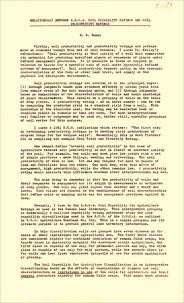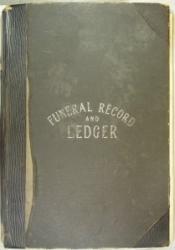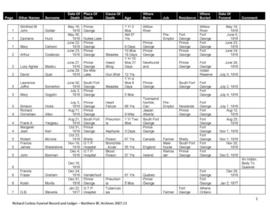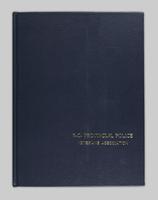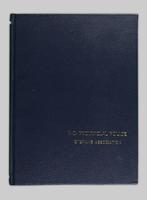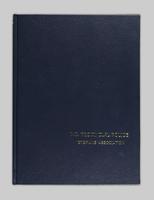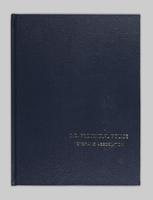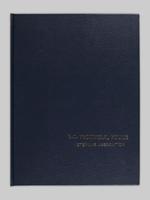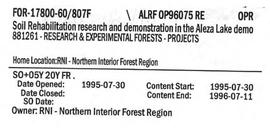Item is an original BC Parks report entitled "Preservation and Management of the Grizzly Bear in B.C. Provincial Parks: The Urgent Challenge".
File consists of a speech given by Gary Runka entitled "Private Land Needs and the BC Agricultural Land Commission Experience" for the Perspectives on Natural Resources Symposium II at Sir Sanford Fleming College in Lindsay, Ontario.
Commentary on this speech by Barry Smith of the Ministry of Agriculture and Lands:
"This represents a major, out of province speech. It covers some familiar historic themes concerning the implementation of the BC farmland preservation program but also provides other interesting insights. It includes an informative summary of the land scarcity problem particular to BC.
With the designation of the ALR complete, the much more difficult task is: "... to make the right land-use decisions within the agricultural zone and encourage good land use planning adjacent to it in order to accomplish the stated objectives." This statement clearly establishes the perspective that the ALC is not just focused on land within the ALR but believes its protection mandate extends beyond the bounds of the Reserve.
GGR states that for competing uses there are normally non-agricultural alternatives but: "...the ability and willingness to go in these other directions necessitates a radical change in thinking on the part of governments, private industry, real estate interests, and the general public." Fourteen competing land uses are noted.
It is noted that the ALC Act "...has provided impetus for more formal planning at the local and regional levels..." - a fact all too often missed.
GGR reviews the types of plan policies that will assist the preservation of farmland and support the continued farming of agricultural land.
A number of specific initiatives are noted and mention is made of the urban / rural fringe problems and the work of the Ministry of Agriculture Green Zone Committee. Mention is made of the challenges associated with dealing with conflicts with other provincial and federal agencies.
The paper is summarized with three general approaches to looking at land needs, land uses and resource planning drawn from GGR's personal experience:
- Canada can't afford many more mistakes in the area of land resource allocation and making land-use decisions on the basis of the land's inherent natural characteristics is more reliable and sensible than based on the protection of property values and simply accommodating growth pressures;
- The ALC has learned that every move in rural planning and every decision in resource management has impact upon agriculture; and
- Agricultural land preservation represents a provincial priority and it has identified a direction around which all others can plan.
GGR closes - "In the final analysis, it is the process of planning that is important, the product itself is never quite finalized."
File consists of a speech given by Gary Runka entitled "Problems and Solutions: The BC Land Commission Experience" at the Conference on Agricultural Land Preservation in Washington State at the University of Washington, Seattle.
Commentary on this speech by Barry Smith of the Ministry of Agriculture and Lands:
"This speech, written for and delivered to an international audience, reads like an article aimed at providing an historical overview of the first three years of the work of the Land Commission.
While succinct, it also has the quality of a comprehensive overview. Up to this point this is the best item in the collection explaining the background of the legislation, implementation and administrative challenges of the Commission over its first three years of operation.
Given when it was written - at a time when the formative history of the Land Commission was being made and by a person in the very centre of this history who was day-by-day helping to create this history - this is a singularly important document."
This born-digital "Profile Descriptions" document provides descriptions of Williams Lake (Skulow Lake), Aleza 1 & 2, Log Lake, and Lucille Mountain pedons.
During a year away from studies in 1987-88, Dr. Paul Sanborn developed a successful grant proposal to the Science Council of BC (SCBC) to pursue a postdoctoral project with Dr. Tim Ballard in relation to sulphur-deficient soils in BC and prescribed fire. This project built on an existing broadcast burning study conducted by Macmillan Bloedel Ltd. near Port Alberni on Vancouver Island, led by Bill Beese (later at Vancouver Island University). Dr. Sanborn's work addressed sulphur forms and amounts in the soils at these sites, and the chemical processes influencing sulphur availability in relation to prescribed fire.
Only one part of this work was eventually published:
Sanborn, P.T. and T.M. Ballard. 1991. Combustion losses of sulphur from conifer foliage: Implications of chemical form and soil nitrogen status. Biogeochemistry 12: 129–134.
https://doi.org/10.1007/BF00001810
The remainder of the work was documented in this Project Completion Report to SCBC, dated February 28, 1990, and entitled "Effects of Prescribed Fire on Sulphur in Forest Soils".
File consists of a speech given by Gary Runka entitled "Proposed Hydro Development - Peace River Valley: Some Questions" to the Peace Valley Environmental Association in Dawson Creek. Note that page 3 of the speech appears to be missing.
Commentary on this speech by Barry Smith of the Ministry of Agriculture and Lands:
"The speech discusses some broad questions particularly related to the lack of a provincial energy policy, the approval process and varying estimates of future energy needs and alternatives. GGR quotes the position of the ALC of October 1977 and also reviews the legal powers under the ALC Act and ends by outlining several questions he feels the Association has the right to ask and get answers to."
Item is a photocopy of "Provincial Parks and Stone Sheep: 'Affinity Through Default'" report by W.G. Hazelwood, Parks Biologist.
Item is an original report by H.M. Pogue titled "Regeneration and Growth of White Spruce After Logging".
Item is an original draft copy of "Regional Landscapes for the British Columbia Parks System".
In the mid-1990s, Dr. Paul Sanborn worked with Dr. Lito Arocena of UNBC to assemble and interpret basic physical, chemical, and mineralogical data for typical soils at important long-term forestry research sites in central and northeastern BC. The key results were published as:
J.M. Arocena and P. Sanborn. 1999. Mineralogy and genesis of selected soils and their implications for forest management in central and northeastern British Columbia. Canadian Journal of Soil Science 79: 571-592. https://doi.org/10.4141/S98-07
Nine pedons were involved, with 7 located at the sites of 4 Ministry of Forests Experimental Projects (E.P.), and 2 at the Aleza Lake Research Forest.
File consists of a speech given by Gary Runka entitled "Relationship Between A.R.D.A. Soil Capability Ratings and Soil Productivity Ratings".
Commentary on this speech by Barry Smith of the Ministry of Agriculture and Lands:
"This is a very useful overview of the agricultural capability ratings.
While no mention is of course made in this (circa) 1969 speech to the BC farmland preservation program, its value rests in the importance of the BCLI in the original designation the ALR and its future administration.
For anyone that is or has been involved with the farmland preservation program, this single sentence within the speech, made about 4 or 5 years before the designation of the ALR, provides an important insight into the value of the CLI and its relationship to farmland preservation. "For example. Class 5 soils while restricted in use to pasture or hay can produce very high yields."
Item is a photocopied "Report on Mt. Edziza, Tatlatui, Spatsizi" by Bob Henderson.
File consists of the following materials:
- Letter to Vernon C. Brink from the National Archives of Canada re: Knox McCusker holdings (March 1, 1999)
- Photocopy of article: "Living Landscapes: Exploring the wilds of northeaster BC" by Ross Peck and Brian Apland
- Some materials for an article on Knox McCusker, D.L.S.
- Material about the life of Knox Freeman McCusker
- Letter to Mrs. Rutherford (Oct. 5, 1999) re: access to interview of Knox McCusker by Frank Willis
- Accession information print-out re: interview of Knox McCusker by Frank Willis in 1954
- National Archives of Canada accession information print-out re: Dominion Land Surveyor Diaries, 1881-1930
- Mary Henry / Knox McCusker "Team" (April 19, 1998)
- Letter to Mrs. Rutherford from George Ungar re: background information on Knox McCusker
Item is a draft of "Resource Analysis 1984, Project No. 26, Silvicultural Systems" by J. Revel.
File is a Resource Folio of maps and accompanying information created by Northwood Pulp & Timber regarding Timber Sale Harvesting Licence A01847, Willow River Block, Willow River P.S.Y.U. Includes maps that depict ungulates, waterfowl, recreation areas, special influence areas, and timber types. Most of the sheets have a duplicate, some with very slight variations. The following maps are supposed to be included in the but were missing upon arrival at the Archives: fish & topography, cutting permits & roads, and soils.
File consists of a speech given by Gary Runka entitled "Resource Use Conflicts - The Fight Over What's Left" at the Canadian Bar Association Winter Meeting, Harrison Hot Springs.
Commentary on this speech by Barry Smith of the Ministry of Agriculture and Lands:
"The panel discussion that GGR was participating in was entitled "Resource Use Conflicts - The Fight over What's Left".
GGR makes the point that without legislative steps to preserve agricultural land in BC, what would be left in terms of farmland in not too many years would be "nothing at all". After this reinforcement of the need for the Land Commission Act he explains briefly the designation of the ALRs and comments at length on the different types of applications.
It is explained that the ALR is based upon agricultural capabilities of the land:
"In other words, a soil/climate combination. The ALR is aimed at preserving agricultural land in the long term. Factors, such as parcel size, economic viability, current market conditions, ownership etc. play little or no role in the decision-making process."
In light of a considerable amount of the Commission's workload being focused on the processing of applications GGR remarks that:
"If we are sincere in our attempts to preserve an agricultural land base for future generations of British Columbians, we must regard the ALR as only a first step of many that are needed."
A flow chart is referred to but not included in the package."
Item is a copy of "Review of Cutting Practices in the Spruce-Balsam Stands" in the Prince George Forest District.
Item consists of one funeral ledger that contains personal information regarding individuals' causes of death, their name, age, and place of residence. The ledger also contains information regarding payment for caskets or other funeral arrangements.
Transcript of the contents of the Richard Corless Funeral Ledger made by the Prince George Genealogical Society. Transcript includes a column of comments by the transcriber providing some additional information and corrections.
This document is a photocopy of a 1994 draft report prepared by Scagel, Hickling, and Evans for BC Ministry of Forests, Silviculture Branch. The document includes annotations by Lorne Bedford, BC MoF (ret.).
Item is an issue of "Forest Management Notes" on "Scarification in the Spruce Alpine Fir type of the Prince George Forest District" by J.R. Gilmour and J. Konishi.
Item is an original issue of British Columbia Forest Service Research Notes on "Seed Production of Hemlock and Cedar in the Interior Wet Belt Region of British Columbia related to Dispersal and Regeneration".
Item is an original Silvicultural Research Note on"Selective Logging of Spruce in Sub-Alpine Alberta" by L.A. DeGrace.
File consists of a speech given by Gary Runka entitled "Sharing the Land Resource - 1990 and Beyond" for Symposium: Local Agriculture, 1990 and Beyond (CNC, FAS-UBC & BCMAF) - November 28,1981.
Commentary on this speech by Barry Smith of the Ministry of Agriculture and Lands:
"This speech starts by looking at land philosophically and states (p. 2): "We sometimes need to be reminded that we are borrowing the land resource from the next generation".
The speech includes several important points made with clarity. A few examples include:
- the need to provide adequate linkages and lines of communication between agencies and different levels of government;
- while understanding the land is prerequisite to its wise and proper use - we still have incomplete and small scale inventory work available;
- nature's laws affirm rather than prohibit. If you violate her laws, you are your own prosecuting attorney, judge, jury.... and hangman;
- do our planning and direct our growth from within the confines of natural systems to take advantage of their attributes and avoid their negative aspects; and
- we need to not only understand land and water ecosystems but the people complex as well - and a great deal of patience and interdisciplinary compromise is needed.
A number of issues are reviewed:
- The agricultural - forestry interface
- Urban dreams meet rural realities
- The challenge of educating an increasingly urbanized population
- Escalating energy costs
- The competition for water"
This paper by Brad Hawkes describes, from a newspaper media's perspective, changes in how fires were fought, reported, and described from 1912-1961 for significant fire years in the Prince George area.
Hawkes, Brad C.This PDF contains site location data and annotated soil profile photographs for soil charcoal samples at the Silver City section (site Y03-11).
This PDF contains 2009 Kluane site notes that include details of transect locations and sampling sites. Grassland pedons selected for Pautler et al. (2014) are indicated.
This image appears as Figure 2 in the publication:
Sanborn, P., 2010. Soil reconnaissance of the Fort Selkirk volcanic field, Yukon (115I/13 and 14).
In: Yukon Exploration and Geology 2009, K.E. MacFarlane, L.H. Weston and L.R. Blackburn
(eds.), Yukon Geological Survey, Whitehorse, Yukon. pp. 293-304.
https://emrlibrary.gov.yk.ca/ygs/yeg/2009/2009_p293-304.pdf
This image appears as Figure 4 in the publication:
Sanborn, P., 2010. Soil reconnaissance of the Fort Selkirk volcanic field, Yukon (115I/13 and 14).
In: Yukon Exploration and Geology 2009, K.E. MacFarlane, L.H. Weston and L.R. Blackburn
(eds.), Yukon Geological Survey, Whitehorse, Yukon. pp. 293-304. https://emrlibrary.gov.yk.ca/ygs/yeg/2009/2009_p293-304.pdf
This image appears as Figure 11 in the publication:
Sanborn, P., 2010. Soil reconnaissance of the Fort Selkirk volcanic field, Yukon (115I/13 and 14).
In: Yukon Exploration and Geology 2009, K.E. MacFarlane, L.H. Weston and L.R. Blackburn
(eds.), Yukon Geological Survey, Whitehorse, Yukon. pp. 293-304. https://emrlibrary.gov.yk.ca/ygs/yeg/2009/2009_p293-304.pdf
This image appears as Figure 9 in the publication:
Sanborn, P., 2010. Soil reconnaissance of the Fort Selkirk volcanic field, Yukon (115I/13 and 14).
In: Yukon Exploration and Geology 2009, K.E. MacFarlane, L.H. Weston and L.R. Blackburn
(eds.), Yukon Geological Survey, Whitehorse, Yukon. pp. 293-304. https://emrlibrary.gov.yk.ca/ygs/yeg/2009/2009_p293-304.pdf
This image appears as Figure 8 in the publication:
Sanborn, P., 2010. Soil reconnaissance of the Fort Selkirk volcanic field, Yukon (115I/13 and 14).
In: Yukon Exploration and Geology 2009, K.E. MacFarlane, L.H. Weston and L.R. Blackburn
(eds.), Yukon Geological Survey, Whitehorse, Yukon. pp. 293-304. https://emrlibrary.gov.yk.ca/ygs/yeg/2009/2009_p293-304.pdf
This "Soil Profile Description: Kiskatinaw LTSP Site" document provides a description of Kiskatinaw pedon.
The key results from the regional soil mineralogy study were later published as:
J.M. Arocena and P. Sanborn. 1999. Mineralogy and genesis of selected soils and their implications for forest management in central and northeastern British Columbia. Canadian Journal of Soil Science 79: 571-592. https://doi.org/10.4141/S98-07
While at the Ministry of Forests, Dr. Paul Sanborn carried out two retrospective studies which examined soil chemical properties at long-term silvicultural research sites where different vegetation types had been created, either as planned or unplanned experiments. These studies were Experimental Project (EP) 660 and a research project at the Archie Creek site.
In July 2009, Dr. Paul Sanborn undertook the first soils field research at the Fort Selkirk volcanic field in central Yukon, with helicopter support and funding from the Yukon Geological Survey. This document is a complete transcription of field notes, with
soil and site photographs.
File contains correspondence regarding funding for research project and computer generated maps.
Item is a "Soil Survey Report on Part of Aleza Lake Forest Experimental Station" by R.A. Fisher of the Forest Surveys Division, British Columbia Forest Service.
With support from the Muskwa-Kechika Trust Fund as a Seed Grant, Dr. Paul Sanborn carried out a pilot study of soils in relation to prescribed burning in the Northern Rocky Mountains, in collaboration with Perry Grilz, then a Range Officer in the Ministry of Forests. Sanborn and Grilz conducted 3 days of field work in July 2001. Sanborn wanted to test the utility of plant-derived opal (phytoliths) as a soil indicator of vegetation history, in the hope of distinguishing natural grasslands from those created by anthropogenic burning.
The Kluane Lake area of SW Yukon was a continuing focus of Dr. Paul Sanborn's research for more than a decade, and generated several productive collaborations. Key themes included biological soil crusts in boreal grasslands, and interactions between aeolian sediment deposition, slope processes, and fire in boreal grassland and forest soils.
Research results appeared in these publications:
Marsh, J., Nouvet, S., Sanborn, P., and Coxson, D. 2006. Composition and function of biological soil crust communities along topographic gradients in grasslands of central interior British Columbia (Chilcotin) and southwestern Yukon (Kluane). Canadian Journal of Botany 84: 717-736. https://doi.org/10.1139/b06-026
Pautler, B.G., Reichart, G.-J., Sanborn, P.T., Simpson, M.J., and Weijers, J.W.H. 2014. Comparison of soil derived tetraether membrane lipid distributions and plant-wax δD compositions for reconstruction of Canadian Arctic temperatures. Palaeogeography, Palaeoclimatology, Palaeoecology 404: 78-88. https://doi.org/10.1016/j.palaeo.2014.03.038
Sanborn, P. and A.J.T. Jull. 2010. Loess, bioturbation, fire, and pedogenesis in a boreal forest – grassland mosaic, Yukon Territory, Canada. 19th World Congress of Soil Science, Soil Solutions for a Changing World 1 – 6 August 2010, Brisbane, Australia. http://www.iuss.org/19th%20WCSS/Symposium/pdf/0120.pdf
The 2003 field work with Darwyn Coxson was a pilot study to assess the types and distribution of biological soil crusts in boreal grasslands in the Kluane Lake area. Eight sites were visited at which the team sampled the crust and the uppermost A horizon immediately underneath it. Note that site numbers Y03-03, -04, -05, -06, -07, -09, -10 and -12 were indicated as sites 3, 4, 5, 6, 7, 9, 10 and 12 in Table 1 of Marsh et al. (2006). Additional crust sampling was conducted at two additional sites (“Peninsula”, “Silver City”) in 2004; details of sampling methods and site locations are in Marsh et al. (2006).
Results from 2009 field work were presented in Sanborn and Jull (2010), along with soil charcoal radiocarbon dates from 2003-2008 sampling which were used to reconstruct fire history in the Kluane Lake area. The 2003 (a single site at Silver City), 2004, and 2008 field work consisted of a reconnaissance of grassland and forest sites across a range of aspects and slope positions in order to recover buried soil charcoal.
